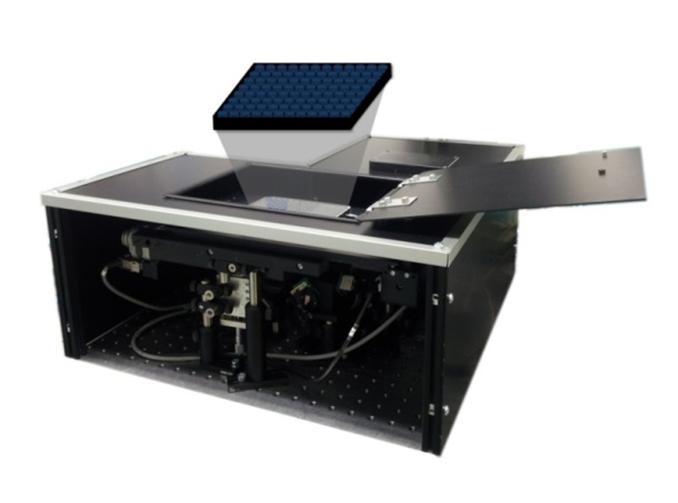New process for cell transfection in high-throughput screening

Functional model for high-throughput screening. Illustration: LZH
This transfection method is characterized by molecules entering the cells through an optically induced process. By attaching the gold nanoparticles to the cells, a photothermal effect is achieved under laser irradiation, which enables an efficient transfer of molecules into the cells.
Many advantages by changing the method
In comparison to the established methods for cell transfection, the risks and efforts can be considerably reduced by the gold nanoparticle process. The use of an optical mechanism also makes the method much more independent from the cell type and molecules used. Also, within larger samples, the transfection can be carried out both more precisely and cell-specifically.
Application tests and method comparisons for customers
Within the course of the project, a large amount of application data could already be collected, and application fields could be verified. The Biophotonic Imaging & Manipulation Group offers testing services for customer-specific methods and questions. Also, methods for cell transfection processes can be compared according to customer requirements.
Follow-up project with new partners
The project has been successfully completed by presenting a functional model. Now, the scientists are planning to continue their work. Methods for use in high-throughput testing shall be further developed and made ready for the market. Presently, the LZH is looking for partners from the screening area to build a prototype in the follow-up project.
The project “Setup and testing of a functional model for gold nanoparticle-based (GNOME) laser transfection in high throughput mode” is IGF project no. 18129 N of the Forschungsvereinigung Feinmechanik, Optik und Medizintechnik F.O.M. (Reseach Consortium Fine Mechanics, Optics and Medical Technology). It is supported via the German Federation of Industrial Research Associations “Otto von Guericke” e.V. (AiF) within the framewok of the Industrial Joint Research (IFG) of the Federal Ministry for Economic Affairs and Energy (BMWi). The members of the advisory committee were: Center for Applied Nanotechnology (CAN) GmbH, Cenix BioScience GmbH, European ScreeningPort GmbH, IBA GmbH, LaVision BioTec GmbH and LLS Rowiak LaserLabSolutions GmbH.
Media Contact
All latest news from the category: Process Engineering
This special field revolves around processes for modifying material properties (milling, cooling), composition (filtration, distillation) and type (oxidation, hydration).
Valuable information is available on a broad range of technologies including material separation, laser processes, measuring techniques and robot engineering in addition to testing methods and coating and materials analysis processes.
Newest articles

A universal framework for spatial biology
SpatialData is a freely accessible tool to unify and integrate data from different omics technologies accounting for spatial information, which can provide holistic insights into health and disease. Biological processes…

How complex biological processes arise
A $20 million grant from the U.S. National Science Foundation (NSF) will support the establishment and operation of the National Synthesis Center for Emergence in the Molecular and Cellular Sciences (NCEMS) at…

Airborne single-photon lidar system achieves high-resolution 3D imaging
Compact, low-power system opens doors for photon-efficient drone and satellite-based environmental monitoring and mapping. Researchers have developed a compact and lightweight single-photon airborne lidar system that can acquire high-resolution 3D…





















